Having played Commander for over a decade, it’s easy to illustrate how options for any given color identity have never been as plentiful as they currently are. Every year, we’re bound to see a cycle of two color ally and/or enemy commanders, and shard or wedge commanders at least once in a two year span. Before Commander 2011, this was by no means the case. The most popular commanders were cards tuned for competitive formats, who rose to the top because they facilitated what the color identity represented. But it eventually begged the question: how have the different color identities of Commander shifted over the last decade and half?
As I have been working through my Commander product retrospectives, I sometimes reflect on how restrained the design space was in those early years. Three-color generals have always been extremely popular, representing pillars of the format, with only the five color good stuff deck outpacing their respective power levels. But the makeup of those pillars has shifted in ways I didn’t realize until sitting down to start analyzing this topic.
Previously, we looked at the past and present shard commanders, which was a journey in and of itself, realizing how much the archetypical makeup of each of those identities had shifted. Today, we will be doing the same with the commanders for each of the five wedges. In the beginning, we only had the five Planar Chaos dragons. A lot of the precedent for these color identities was set by the Commander 2011 product. Because the first big push to design wedge commanders was directly tied to the Commander products, I imagine we see the perceived successes and failures on how these five color identities have shifted over the last dozen years. A lot has changed and some things have proven to remain eternal.
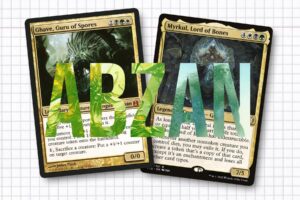
Abzan
In the early years of Commander, Teneb, the Harvester and the other Planar Chaos dragons were the only options for wedge commanders, outside of Doran, the Siege Tower. In fact, when I was introduced to wedges, it was through a player who referred to the different color combinations by their nicknames, brought to us by the Volver cycle in Invasion block. If Khans of Tarkir block did nothing else, it thankfully gave the players actual memorable names for the three-color combinations. I never would have been able to casually work in how Teneb was the Necra commander during conversations.
At the introduction of the format, Teneb, the Harvester was this slow, plotting deck which would remove threats with all-round good answers like Angel of Despair, Mortify, and Putrefy. Once the path was clear, they would start reanimating worthwhile creatures and dishing out commander damage. From those humble beginnings, the color identity we would one day know as Abzan had a reasonable shakeup in 2011 with the printing of Ghave, Guru of Spores. Suddenly the marquee reanimator deck was becoming this notable combo machine, setting up cards like Sigil Captain or Grave Pact to seemingly splinter off into dozens of decision trees. While not the most popular commander, the power level of Ghave was figured out rather quickly, setting a strong precedent.
Of those discussed today, Myrkul, Lord of Bones is the commander I know the least about. My understanding is it serves as a continuation of Abzan as the aristocrats combo deck. This means over the last decade the color identity remained fairly focused among the ten factions discussed last month. Myrkul’s ability to add enchantments, and by extension Constellation, develops the decision tree of game play results in a deck possessing a lot of pieces I would expect to see in a Tuvasa the Sunlit deck>. But unlike Tuvasa, it has a win condition looking to drain your life away via Zulaport Cutthroat instead of simply outdrawing the table like a typical enchantress deck.
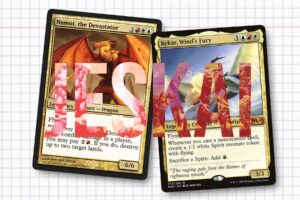
Jeskai
While all of the Planar Chaos dragons had some level of relevance prior to Commander 2011, I would venture to say Numot, the Devastator was the only one besides Teneb to have been a popular commander, even if other options were readily available. Numot may feel like a relic of a different time now, but at the time, they were the commander legitimizing land destruction as a route to victory. Where many would rest solely on Ruination or Armageddon as their single mass land destruction spell, Numot regularly leaned in on the cards like Jokulhaups and Omen of Fire, and is the only reason I know that Global Ruin exists. While I will never entirely advocate for mass land destruction, I think having Numot in at least one of my local metas made me more prepared for the strategy.
When Commander 2011 came around, Zedruu the Greathearted and Ruhan of the Fomori represented a more friendly face for the would-be Jeskai color identity. Zedruu won out in the popularity contest and helped carve out space in the Group Hug archetype for Jeskai. The biggest issue holding her back at the time was cards you’d want to donate away didn’t exist in a wide range. She sometimes needed other spells to help donate around the color intensive cost of her printed ability. Zedruu has kept a reasonably strong profile over the years, taking on cards like Harmless Offering, Nine Lives, and Sudden Substitution. And as someone who was there at the time, I’m happy to see she still gets some love.
The popularity of Kykar, Wind’s Fury is a little deceptive at first glance. My mind typecasted Kykar as a spellslinger commander, capable of closing the gap when trying to chain spells together. But in reality, Kykar is more often used as the polymorph commander of choice. And through this lens, the popularity of Kykar makes a lot more sense. The Jeskai color identity has always felt like the home of spell-based decks, but fusing them with the overall growth in creature power level and token generation, a deck sporting Divergent Transformations, Transmogrify, and Mass Polymorph does sound pretty fun. Before starting my research, I would have assumed Hinata, Dawn-Crowned or Elsha of the Infinite took this top spot. But I also think these strategies exist so much on the stack, so they are probably more daunting to build and play with. If Jeskai is the present home of a polymorph archetype, that’s pretty cool.
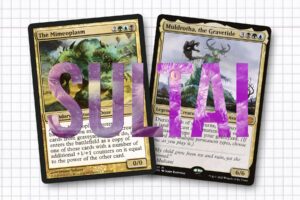
Sultai
The Mimeoplasm was the coolest damn thing at release. Beyond representing a Clone deck with graveyard hate utility, being a commander which could giant-size any creature and had a dinosaur arm was awesome all in itself. Graveyard tutors, like Buried Alive and Emtomb, saw a lot of play at the time. Creatures like Lord of Extinction and Simic Sky Swallower were some of the most popular targets the deck itself would supply. But the real fun was taking a good creature from an opponent’s graveyard as the copy and piling a dozen tokens onto it, often making for a two turn clock.
This focus on the graveyard remained synonymous with Sultai over the next decade, so it should be no surprise Muldrotha, the Gravetide reigns supreme over the wedge. Muldrotha is a completely different beast entirely; in some respects a mill deck and others a sacrifice engine for graveyard good stuff. It can be hard to list off the good cards Muldrotha uses, because she can tool box into any number of answers. It’s up to the deck designer to tailor the combos at hand to their personal metagame. The end result is a deck more solitary than the more reactive and interactive deck The Mimeoplasm represented. Lastly, as someone who has built their share of Blue-Black-Green decks, I do wish we’d seen more exploration of the design space carved out by Damia, Sage of Stone. But this may also be far more of a personal longing.
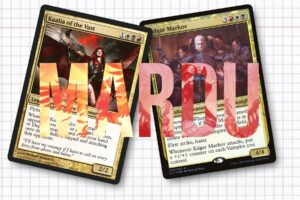
Mardu
Kaalia of the Vast marked the first time a three color identity was strongly associated with a tribal strategy. To Kaalia’s credit, she had the decency to at least helm three different iconic tribes. Because of the popularity of angels and demons, especially, Kaalia decks have always been very popular. I’m surprised they didn’t come up as a topic of conversation when I discussed oppressive commanders from the early years of Commander. With hindsight, I would say Kaalia was something to keep your eye when she did show up, but outside of the then-legal Iona, Shield of Emeria and Gisela, Blade of Goldnight, the deck didn’t feel unfair when compared to the other things you could in the 2011 to 2013 metagame.
Edgar Markov, on the other hand, has been in the conversation when I discussed the topic of de facto best generals for tribes and my look back at Eminence, a year after its introduction. Playing against Edgar has always been a little demoralizing, because his Eminence ability allows him to start applying a lot of pressure from the first turn of the game. Nowadays, I imagine the ability might only trigger once a turn and honestly, for all the criticism I give the card, I think the powered-down version would lose too much of the fun. Commander 2017 felt like a turning point when tribes really started to get a very strong design push. Edgar Markov is the poster child for the change. Armed with vampires ranging from Twilight Prophet to Olivia Voldaren, Edgar represents a deck living up to the hype Kaalia inspired, but never truly matched. Sadly, his existence removes a lot of discussion about the best general for the vampire tribe.
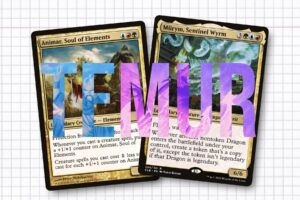 Temur
Temur
I remember someone comparing Animar, Soul of Elements to Akroma, Angel of Fury when it was first previewed. Not really an accurate comparison in retrospect, but fair for the time. Protection is a fairly uncommon ability to have a legendary creature and at the time, it was the first three color general to have it and the fourteenth overall. Animar is a wedge commander immune to two of the major removal colors, one which could quickly outgrow a lot of what Red could throw at it. This made Animar a highly versatile general which helped to establish a lot of different archetypical creature decks, ranging from morph tribal to slivers. This highly adaptive design has kept Animar relevant, falling only behind our last card.
Miirym, Sentinel Wyrm has had a meteoric rise in the short time it has existed. But I’m happy to see Temur still cares about creatures and The Ur-Dragon has some competition. While it is not something I have gone out of my way to publicly express in too many places, I do think there is a need for five-color tribes to have notable powerful generals occupying a more condensed color identity. Especially when thinking about a tribe like slivers.
The fact Miirym creates copies of nontoken dragons at no cost is a little unreal, when you think about it. While I don’t necessarily know if I will ever build a Miirym deck, I appreciate it’s sufficient-enough power level to create a variance in the deck building of dragon decks. But it also feels weird for me to definitively say how Miirym is somehow the face of Temur, when they are so strongly tied to a specific tribe. In some respects, I would be okay saying that Animar has continued to be the face of Temur, one which has proven to be a longstanding commander who can adapt remarkably well to the changing meta game.
When I set out to start writing this series, I thought the crux of what I was going to be examining was how differently creature design has changed as Commander has come more into focus over the last decade. But once you dive back into the Commander 2011 designs, you see how much Wizards was swinging for the fences. It set the bar for what wedge commanders designs could be. What is also telling is the next consistent cycle of commanders within these five color identities didn’t come along until 4 years later with 2014’s Khans of Tarkir block, a wild thought when you realize that in the last 4 years, as of the writing of this article, we’ve seen nine Temur commanders, alone.
I would like to continue this series of examinations, looking at two color identities in mirrored future articles, but I think it may be some time before I’m really ready to take on that task. Regardless, I hope if nothing else, this can maintain some pieces of historical context and educate players for years to come. Thank you for reading
Ryan Sainio (he/him) is a Graphic Designer exploring the Commander format and Magic history on a regular basis. Notable decks that value flavorful and fun gameplay over competitively optimized decks include Shattergang Eldrazi, Doran Soul Sisters, and Chatterfang ProsBloom.
MTG Content Creator Awards 2022 nominee: Format Specialty Writing & Excellence in Writing Overall

